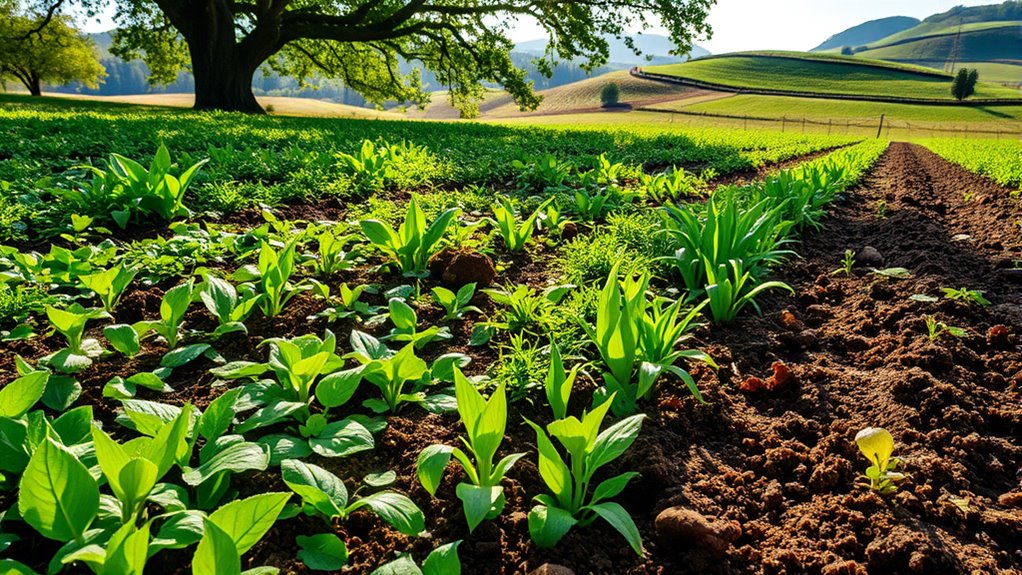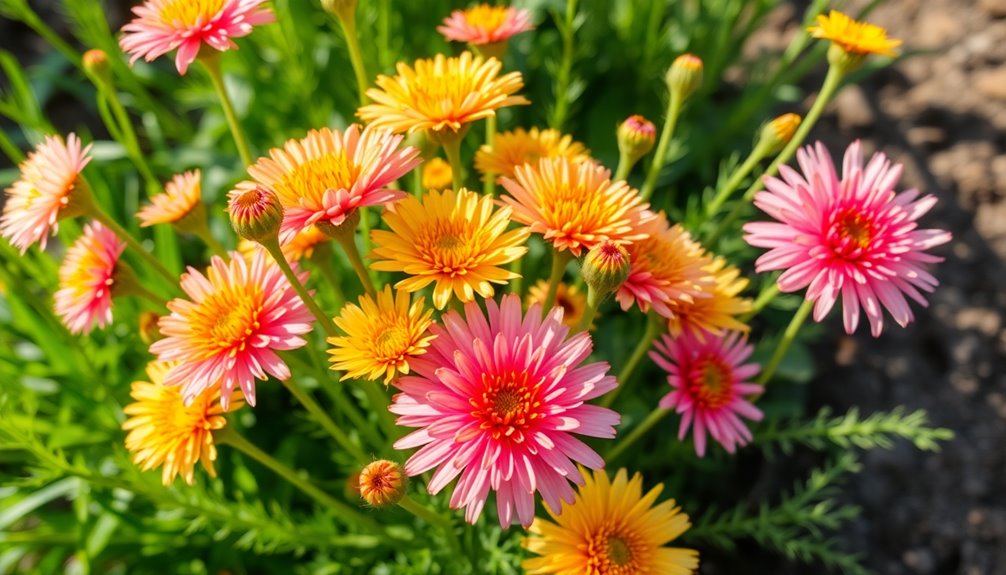Cover crops can greatly boost your soil health by enhancing fertility, reducing erosion, and fostering biodiversity. They improve nutrient management by scavenging leftover nitrogen and fixing atmospheric nitrogen, which helps crops thrive. Additionally, cover crops help prevent soil erosion, promoting stability and structure. You'll save on fertilizer costs while benefiting the environment through better soil quality and reduced runoff. Stick around to discover even more advantages of using cover crops in your farming practices.
Key Takeaways
- Cover crops enhance soil biodiversity, improving nutrient management efficiency and fostering a resilient ecosystem through diverse integration.
- They significantly reduce soil erosion by up to 90% by minimizing runoff and stabilizing soil with root systems.
- Cover crops scavenge leftover nitrogen, with rye capturing 25-100% of residual nitrogen, thus reducing nutrient leaching.
- By improving soil organic matter, cover crops enhance nutrient cycling, leading to better soil fertility and reduced fertilizer costs.
- They support biodiversity and improve water quality by minimizing nutrient runoff and enhancing soil health.
What Are Cover Crops?
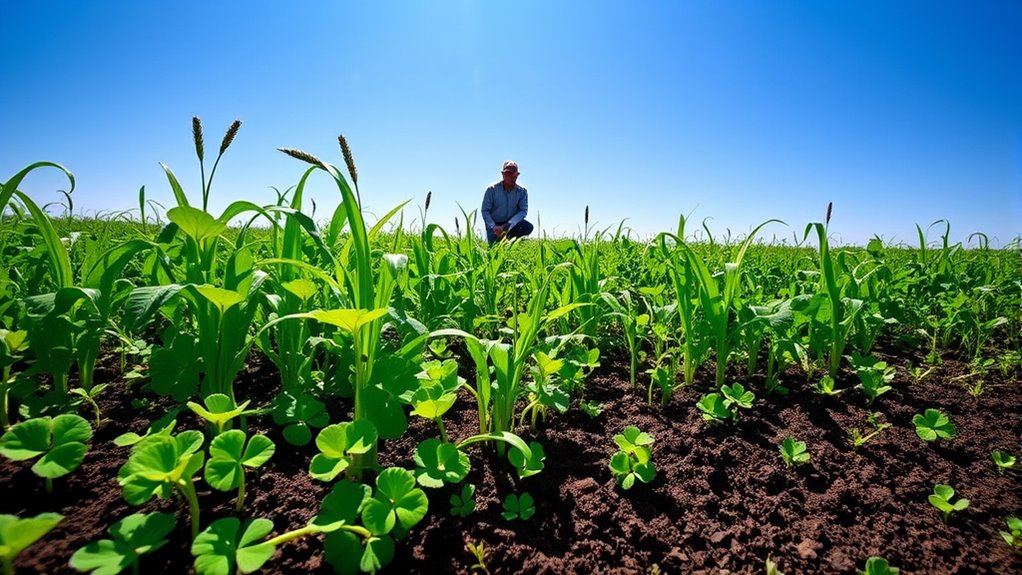
Cover crops play an important role in enhancing soil health and fertility. These plants are primarily grown to improve the soil rather than for harvest, often planted during fallow periods or between cash crops. Common types include legumes, grasses, and brassicas, each offering unique benefits.
By growing cover crops, you can enhance soil structure and increase organic matter, which supports diverse microbial communities. They help reduce erosion and improve water quality by scavenging residual nitrogen, minimizing nutrient leaching into water systems.
Additionally, maintaining living roots in the soil during off-seasons fosters continuous microbial activity, promoting long-term soil health and resilience. Integrating cover crops into your crop rotation can greatly boost your soil's overall vitality.
Key Benefits of Cover Crops for Soil Health
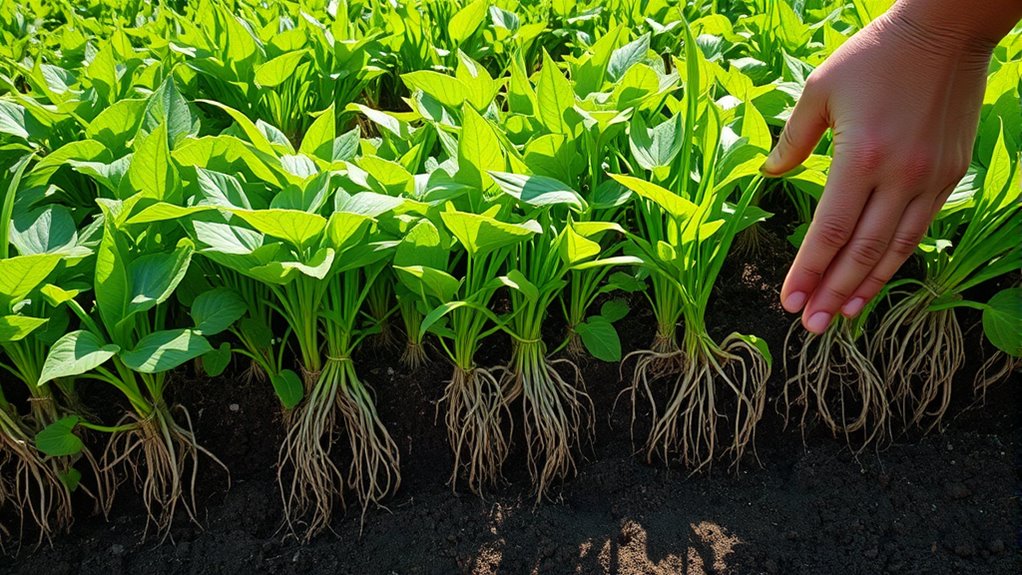
Cover crops offer you several key benefits for soil health that can transform your farming practices.
By enhancing soil biodiversity and improving nutrient management efficiency, these crops foster a more resilient ecosystem.
Plus, they play an essential role in erosion control, protecting your soil from loss and maintaining its integrity.
Enhancing Soil Biodiversity
When you incorporate diverse cover crops into your soil management practices, you're not just planting seeds; you're fostering a thriving ecosystem beneath the surface.
By enhancing soil biodiversity, you create a habitat rich in beneficial organisms that support soil health and resilience. Increased plant diversity from cover crops improves ecosystem function, leading to a stronger soil food web and better disease resistance.
Mixing various cover crop species promotes diverse root systems that enhance soil aeration and moisture retention. Additionally, integrating livestock grazing with cover crops boosts nutrient cycling and increases organic matter.
Greater biodiversity guarantees your soil can withstand environmental stresses, making it essential for sustainable agricultural practices and the long-term health of your land.
Erosion Control Benefits
Incorporating cover crops not only boosts soil biodiversity but also plays an essential role in erosion control.
These plants enhance vegetative biomass, considerably reducing soil erosion by minimizing runoff and protecting soil aggregates during rainfall events. With the ability to decrease soil erosion by up to 90%, cover crops effectively prevent nonpoint source pollution from sediments and nutrients entering waterways.
Their root systems bind soil particles together, improving soil structure and stability, which further mitigates erosion from wind and water. Acting as a protective layer, cover crops shield soil from harsh conditions that can harm its structure and organisms.
Nutrient Management Efficiency
Effective nutrient management is essential for maintaining soil health, and utilizing cover crops can greatly enhance this process. Cover crops improve nutrient management efficiency by scavenging leftover nitrogen, with rye capturing 25-100% of residual nitrogen and reducing nutrient leaching. Legume cover crops, like hairy vetch and clover, fix atmospheric nitrogen, providing 65 to 103 lb. N/A for crops, which lowers the need for synthetic fertilizers. They also enhance soil organic matter, improving nutrient retention and cycling, thereby supporting soil fertility. Integrating cover crops leads to reduced fertilizer costs and promotes sustainable agriculture.
| Cover Crop Type | Key Benefit | Impact on Soil Health |
|---|---|---|
| Rye | Scavenges residual nitrogen | Reduces nutrient leaching |
| Legumes (e.g., clover) | Fixes atmospheric nitrogen | Enhances soil fertility |
| Brassicas | Absorbs excess nitrogen | Improves nutrient cycling |
Enhancing Soil Biodiversity With Cover Crops
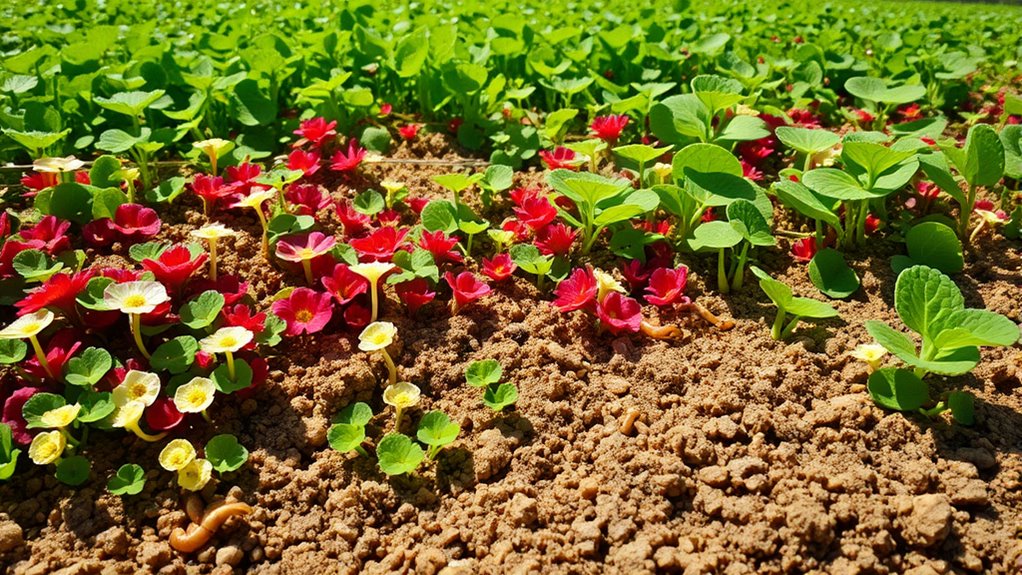
When you use cover crops, you're not just protecting soil; you're also fostering diverse microbial communities that thrive below the surface.
This biodiversity creates essential habitats for beneficial organisms, enhancing the resilience of your soil against diseases.
Diverse Microbial Communities
Cover crops play an indispensable role in supporting diverse soil microbial communities, as they provide crucial habitat and food sources for beneficial organisms. This increased plant diversity markedly enhances soil health and biodiversity, promoting resilience against pests and diseases. By mixing different cover crop species, you improve soil microbial diversity and contribute to nutrient cycling.
| Benefit | Description | Impact on Soil Health |
|---|---|---|
| Increased Biodiversity | More species leads to a robust food web | Enhances ecosystem services |
| Organic Matter | Cover crops boost organic matter content | Improves soil structure |
| Nutrient Cycling | Diverse roots promote better nutrient dynamics | Supports healthy crop growth |
| Resilience | Healthy microbes enhance resilience to diseases | Reduces vulnerability |
| Habitat | Diverse cover crops provide habitats for microbes | Strengthens soil microbial communities |
Habitat for Beneficial Organisms
By enhancing the habitat for beneficial organisms, cover crops greatly contribute to soil biodiversity and overall health.
These crops not only support diverse soil microbial communities but also enhance soil resilience and nutrient cycling.
Here are three key benefits:
- Increased Plant Diversity: Mixing different cover crop species promotes a more robust soil food web, which is essential for soil health.
- Root Exudates: Cover crops release root exudates that feed beneficial fungi and bacteria, boosting microbial activity crucial for nutrient exchange.
- Organic Matter Addition: Integrating livestock grazing with cover crops adds organic matter, further promoting soil biodiversity and overall ecosystem health.
Together, these factors enhance soil health and support a thriving community of beneficial organisms.
Resilience Against Soil Diseases
Enhancing soil biodiversity through cover crops greatly boosts resilience against soil diseases. By promoting diverse soil microbial communities, cover crops create a complex food web that supports beneficial organisms. Increased plant diversity improves soil health, enabling ecosystems to resist and recover from pest and disease outbreaks effectively.
When integrated with livestock grazing, cover crops enhance soil biology and organic matter, further promoting nutrient cycling and disease resilience. They also scavenge leftover nutrients, reducing leaching into waterways and lowering nutrient loads that can contribute to disease pressures.
Additionally, some cover crop species, like cereal rye, suppress soil-borne pathogens through resource competition and allelopathic effects, making your soil even more robust against potential threats.
Improving Nutrient Management Through Cover Crops

When you incorporate cover crops into your farming practices, you can greatly improve nutrient management and enhance soil health.
These crops capture and recycle nutrients, reducing the need for synthetic fertilizers. Here are three key benefits:
- Fix Nitrogen: Leguminous cover crops like clover and vetch can provide 65 to 103 lbs. of nitrogen per acre, boosting soil fertility naturally.
- Reduce Nutrient Leaching: Cover crops scavenge leftover nitrogen, preventing up to 100% of nutrient loss to waterways.
- Enhance Microbial Activity: The organic matter from cover crops improves nutrient cycling, increasing availability for subsequent crops.
Cover Crops and Erosion Control
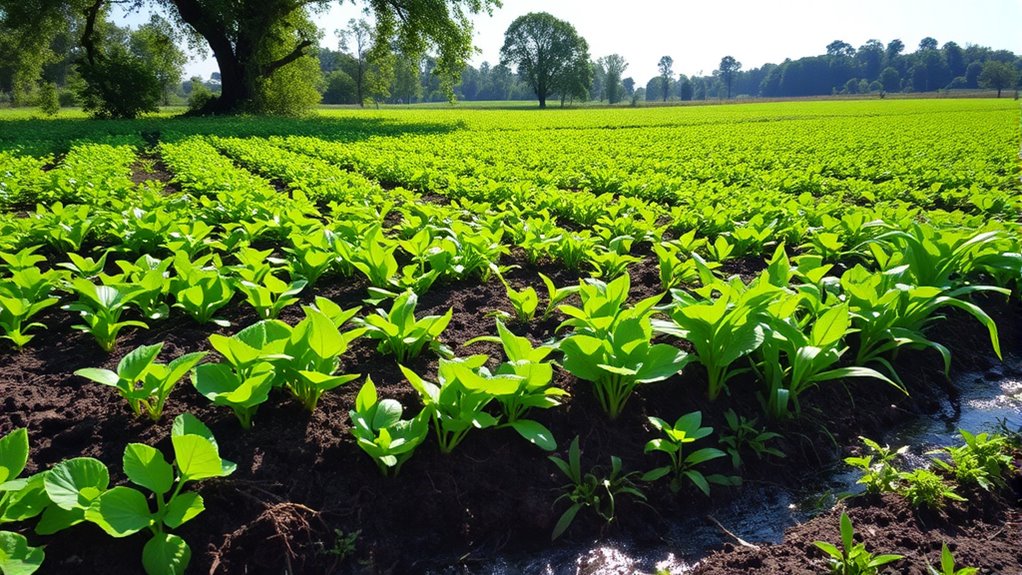
Cover crops play an important role in controlling erosion, especially in agricultural landscapes where soil stability is at risk. By enhancing vegetative biomass, cover crops effectively reduce erosion, protect soil aggregates, and slow down runoff velocity. They can decrease soil erosion by up to 90%, making them crucial in agricultural practices aimed at preserving topsoil. Additionally, cover crops prevent bare soil exposure, shielding it from harmful temperatures during critical establishment phases. In no-till systems, cover crops markedly reduce erosion, even with light tillage operations.
| Benefits of Cover Crops | Impact on Soil Erosion | Agricultural Practices |
|---|---|---|
| Enhances vegetative biomass | Reduces erosion by up to 90% | Prevents bare soil |
| Slows down runoff velocity | Decreases sediment transport | Supports soil aggregates |
| Protects soil from high temperatures | Minimizes wind and water erosion | Effective in no-till systems |
Economic and Environmental Advantages of Cover Crops

While many farmers focus on immediate crop yields, incorporating cover crops can considerably enhance both economic and environmental outcomes.
Here are three key advantages:
- Economic benefits: Cover crops can reduce fertilizer costs by scavenging soil nitrogen and improving crop productivity, leading to higher financial returns.
- Environmental benefits: They considerably reduce soil erosion by up to 90% and prevent nutrient runoff, mitigating nonpoint source pollution.
- Soil health: Cover crops enhance moisture retention, supporting sustainable farming practices and increasing resilience to climate variability.
Frequently Asked Questions
What Is the Best Cover Crop to Improve Soil?
Choosing the best cover crop to improve your soil depends on your specific needs.
If you want to fix nitrogen, consider planting legumes like clover or vetch.
For enhancing soil structure and preventing erosion, grasses like annual ryegrass are ideal.
If you're dealing with compacted soil, try brassicas such as radishes.
Mixing various species can boost biodiversity, leading to healthier soil ecosystems and better nutrient cycling essential for long-term fertility.
How Do Cover Crops Increase Soil Moisture?
Imagine a sponge soaking up water—cover crops do just that for your soil. They increase moisture by boosting organic matter, allowing the soil to retain water better.
Their root systems create channels, improving structure and letting water infiltrate more deeply. As the cover crops die, their residue forms a protective layer, reducing evaporation.
With effective options like rye and wheat, you'll see enhanced moisture availability, especially during dry spells.
How Do Cover Crops and Improved Soil Health Relate to Water Quality?
Cover crops play a vital role in enhancing water quality. When you plant them, they absorb excess nutrients, preventing runoff that can contaminate water sources.
Their roots improve soil structure, allowing better water infiltration, which reduces surface runoff. This means less sediment and pollutants enter waterways.
By suppressing weeds, cover crops also cut down on herbicide use, further protecting water quality.
Do Cover Crops Add Nitrogen to Soil?
"You reap what you sow." Yes, cover crops do add nitrogen to your soil!
Leguminous cover crops like clover and vetch fix atmospheric nitrogen through a partnership with rhizobia bacteria. This process enriches your soil, providing essential nutrients without relying on synthetic fertilizers.
Conclusion
Incorporating cover crops into your farming routine isn't just a choice; it's an investment in the future of your soil. By enhancing biodiversity, improving nutrient management, and controlling erosion, these crops offer a multitude of benefits that can transform your land into a thriving ecosystem. Imagine your soil as a living entity, flourishing and resilient, ready to support generations of crops. So why wait? Embrace cover crops today and watch your soil health thrive like never before.

